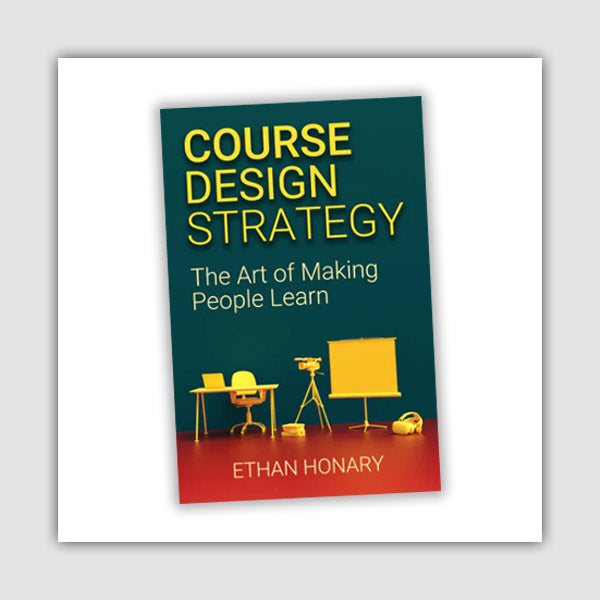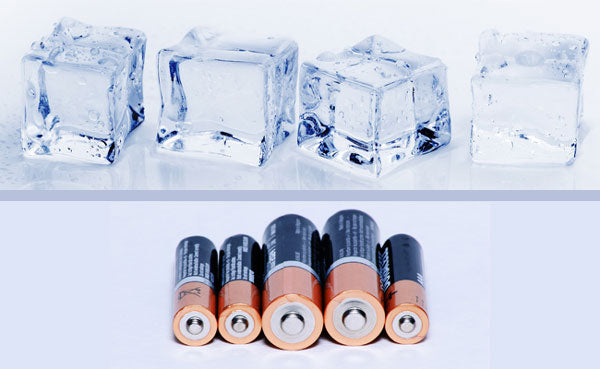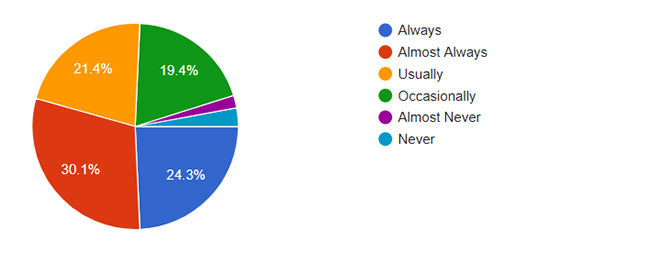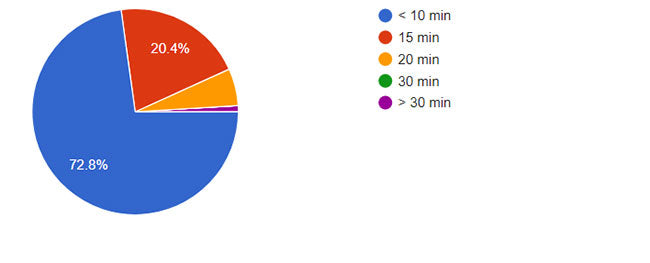We sent a questionnaire to the training community on the use of icebreakers and energiser. We asked questions such as, “Are they useful?”, “How do they help?”, “How long should they be?”, and so on. We have now got the results back and would like to share them with you.
There was a total of 103 respondents from around the world. As always, the results are fascinating and educational. They are then followed by what the training community thinks of them in their own words and how these tools are best used.
The results are presented first using graphs and our analysis is then followed.
Just to be clear to all readers, here is a brief intro to each training tool:
Icebreakers
As the name suggests, thy are used to break the ice, get people to know each other and make them comfortable to participate in the group.
Examples:
I Want This – I Know ThisThis Reminds Me of…
What Do You Do When You Are Not Working?
Energisers
Used to energise and motivate people, break the pace, gain attention, make people feel more positive and make them think.
Examples:
Wake Them UpSynchronised Movement
For the complete collection see index of icebreakers and energisers.
They Survey Results
Do you use an icebreaker at the beginning of the course instead of going through delegate introductions?
When delegates are tired, such as during the afternoon, do you use energisers to wake them up and motivate them?
Irrespective of the course content, do you use favourite go-to exercises used to break the pace, energise people and motivate them?
Do you think it is a good idea to use energisers for adult training?
On average, how many icebreakers or energisers do you use in a day long course?
How long does a typical icebreaker take to run?
How long does a typical energiser take to run?
When using energisers how important is each of the following parameters?
Analysis
- More than 55% of trainers almost always use icebreakers at the beginning of the course. This makes a lot of sense as it is precisely at the start when you may need to bring the delegates closer together and make them feel more comfortable with each other.
- Energisers are naturally ideal for afternoon engagement and the survey results overwhelmingly confirms this.
- Favourite go-to energisers are used by most trainers when needed, but not too religiously.
- The overwhelming majority (97%) believe that energisers are great for adult training. Energisers are not necessarily patronising or childish as some trainers imply. We should be careful in how and when energisers are used, but we cannot dismiss them as a category by labelling them “condescending”.
- Most trainers use 2 or 3 icebreakers or energisers in a day-long course.
- The vast majority (85%) think that an icebreaker should not take longer than 15 minutes, preferably less than 10 minutes.
- In contrast, most trainers (72%) think that an energiser should take less than 10 minutes. Hence, it is critical that energisers don’t drag and tend to be shorter than icebreakers.
- When deciding what energisers to use, the most critical characteristics are identified as:
- It is not critical for an energiser to be directly related to the topic of the course. This is great news, because it means you are not too restricted in your choice of energisers. Though of course if you find one that is related to the course, go ahead and use it.
- Energisers are useful for moving people, making people think and laugh, but they are not critical. You can achieve similar results using a well-designed activity related to the main topic of the course. Off-the-shelf energisers are a tool in your toolbox, to use when the circumstances dictate it.
- Energisers are most often used when delegates are tired. You can plan this in advance for afternoon sessions when you know many delegates can be tired, bored or sluggish due to heavy lunch.
Trainers’ Comments
We also collected views of respondents about icebreakers and energisers. We have divided these views into a series of clusters with representative ideas included so it is easier to understand what the training community thinks.
What Do You Think of Icebreakers?
Cluster 1: Icebreakers Are Essential
- An important part of the program to make participants feel more at ease and less antagonistic.
- reat way to get to know groups from both the trainer and participant aspect. Always looking for new ones.
- They give training a good start.
- I think they’re great, they provide an opportunity for delegates to comfortably interact.
- Very important to create an open learning environment but boring for us to conduct regularly.
- It is really powerful technique to create positive, safety and comfortable atmosphere for participants from the very beginning.
- I think icebreakers are the best tool a trainer can ever have.
- Great way to break down barriers, especially if they are fun and not related to the course topic. We don’t do name, length of service etc... which is what delegates expect.
- They are a vital component of most sessions I run - obviously more so for groups that don’t know each other, but also for groups that have known each other for some time but who don’t typically interact with each other on a day-to-day basis. They are a good way to set the tone for the session and helps to allow people to be comfortable with each other, before getting into any “serious” discussions. Really vital in groups where participants don’t know each other at all.
- Very important to help participants relax and gauge the facilitators style. Most helpful to the facilitator to gain a sense of who is more outgoing, interaction style, shyness, etc.
- It relaxes participants and gears them up for an enjoyable course.
- Icebreakers set the pace of the training session, and create harmony and bonding within the group. Icebreakers are absolutely essential.
- Very important to break preoccupation with pressures of work and lead into the topic to be covered.
- I think it’s important to set the tone and pace of the training. I often try and link the icebreaker activity with the module I am training. It also gets people more comfortable with environment and getting to know each other.
- As a facilitator, I follow Bob Pike’s concept of icebreakers. I believe icebreakers are used at the start of the training or start of the day (if needed). As the name itself indicates, they are used to break the ice, bring the participants in to the comfort zone. Make them feel at ease to ask questions and collaborate.
- They are useful as water is for life.
- It is imperative to bring the trainees to the training room – mentally.
- Breaks tensions in a mixed group, it develops communication and community, builds trust and openness, the atmosphere becomes very relaxed.
- Very important to leave lasting memorable messages.
- Depending - sometimes important and sometimes just useful.
- Delegates like it & do not forget it.
- Extremely valuable to break down barriers and to get to know some of the other participants.
- Icebreakers are very important to get attention and motivate trainees to actively participate in interaction.
Cluster 2: Icebreakers Are Not Needed
- Not necessary. Waste of time. They have come to learn and do a course. We are dealing with adults who have come to do a course not be entertained by silly time wasters!!!!
- Find they make people feel a bit awkward.
- Not as common or useful as previously. Training has changed, at least for me.
- I like them as long as they are linked to the course content.
Cluster 3: How to Use Icebreakers
- They are usually more effective if the participants don’t know each other too well.
- I find them most beneficial with a new group of trainees, who are a bit nervous.
- I interchange icebreakers and energizers and use them similarly to address specific needs. Sometimes they are planned to achieve a specific outcome or to anticipate a certain phase/stage in the training; other times I use them as a response to what I am observing in the room in terms of energy, focus or challenging dynamics that I want to address or change.
- I think they get the ball rolling and I like to use a game version if possible and provide prizes to the winning team.
- Thank you Skills Converged for creating some very workable icebreakers. I have especial application of the one where members of same company who think they know everything about each other are made to go around and locate a colleague who has or does this habit or trait: it works to alert them that they can do lots to approach the person next door.
- They are needed to set the climate, but should not take too long.
What Do You Think of Energisers?
Cluster 1: Energisers Are Essential
- Useful to break the state, get people energised and focused and more prepared to learn especially after a break.
- A good pace changer when trainees appear to losing their attention span.
- Absolutely essential to break the pace, add variety, energy & most importantly it becomes experiential learning with better recall.
- It’s like a mini-break energizing people to keep focused on the training content.
- Energisers are important to activate dull and tired delegates.
- I think they’re great. It helps move people from a state of lethargy or disengagement to vitality and engagement.
- They break the monotony and heaviness of a session.
- They are the best gift for groups as they energize them and put them back in the mission.
- Very helpful instrument when participants tired, after coffee break to change the pace, any situation when participant attention is low.
- I think they are needed for any and all presentations.
- Extremely valuable to re-engage the minds or focus for retention of the training material. Attention span for adults is limited and without energisers absorption of critical content is reduced.
- Vital but usually to emphasise course content, not just to re-energise.
- It breaks up the monotony of a day long course, particularly a technical one.
- Energizers are a great way to liven up and motivate trainees when they’re tired. In addition, they are great for change in pace as well as in gliding into a new activity/aspect of the training.
- Keep the motivation to knowledge and learn high. The objective of upskilling is met by energizers.
- Love to use these when the participants are experiencing low energy and it gets them up and moving.
- I love them, as long as they are quick and easy.
- Any activity that stimulates the participants brains or body is an energiser. They have to be short and fun.
- Energisers are required to be brought into action when the trainer realizes that the audience is drifting away from the topic of the workshop, specially important after lunch if it is a daylong workshop.
- It just adds to the atmosphere, it creates creativity and fun, it makes people see each as normal, people become themselves.
- Excellent means to energise participants and increase engagement.
- Also very useful helpful especially for employees who work nights.
- They are oxygen masks. Gets you breathing participants.
Cluster 2: Energisers Are Somewhat Useful
- Other than taking breaks and getting people to interact socially, never really used any but like the idea of using them in the future for larger groups
- Useful but I feel does not go with my serious personality.
- It depends.
- Not as crucial as ice-breakers, but still helpful, particularly post-lunch or whenever energy levels are dipping (also useful after a particularly “heavy” discussion). However, I tend to only use energisers that have something to do with the topic of discussion/learning itself - so, rather than “artificially inserted”, they are part and parcel of the flow of the session. I normally have a few in mind as part of my planning for the session and use them when and if necessary.
- Useful but if you have already planned activities it might not be required.
- Don’t use them as much as icebreakers - but I should.
Cluster 3: Energisers Are Not Needed
- Not really necessary unless the group is a demotivated one and would then break for a relevant writing or talking assignment related to the subject matter.
- I try to structure training so that I don’t need these.
Cluster 4: How to Use Energisers
- I have to think about venue and mobility and what the group might feel comfortable doing but always looking for ideas.
- Always incorporate after any break.
- Good for energizing people after lunch or around 3:00.
- Useful after lunch, or if the class is lagging do to the weather, course content. We sometimes throw them in, even if the class is energised.
- They are useful in getting a group back on track after a tedious morning/afternoon.
- Really good way to engage the group - But they can be over used.
- Use them after lunch when blood sugar rise hits—also important if there is time.
- Energizers are used during the training when you feel the participants are losing the focus and you need to energize them. One occasion I have frequently used energizers, is after the lunch. Meanwhile, I feel it’s not necessary to link the energizers to the content. If possible, it would be great, but not mandatory.
- Will be very good if it is also relevant to the theme of instruction.
- Useful, when short; particularly after lunch.
- Energizers are required to be used after every 2 hours of training, post lunch. It should be a 5 minute activity or a game.
- Energizers are meant to boost the energy level, and keep participants active and engaged during the training sessions especially after “heavy” lunch. It is important to plan relevant (to training topics) energizers as part of the training schedule. To make them relevant, facilitators should summarize gist of the energizer (especially when energizers involve solving problems/dealing with challenges in groups), and make sure that they summarize main points and observations.
Soft Skills Training Materials
Get downloadable training materials
Online Train the Trainer Course:
Core Skills
Learn How to Become the Best Trainer in Your Field
All Tags
Training Resources for You

Course Design Strategy
Available as paperback and ebook

Free Training Resources
Download a free comprehensive training package including training guidelines, soft skills training activities, assessment forms and useful training resources that you can use to enhance your courses.

Our Comprehensive Guide to Body Language

Train the Trainer Resources
Get Insights - Read Guides and Books - Attend Courses
Training Materials
Get downloadable training materials on: Management Training, Personal Development, Interpersonal Development, Human Resources, and Sales & Marketing


















Leave a comment
All comments are moderated before being published.
This site is protected by reCAPTCHA and the Google Privacy Policy and Terms of Service apply.